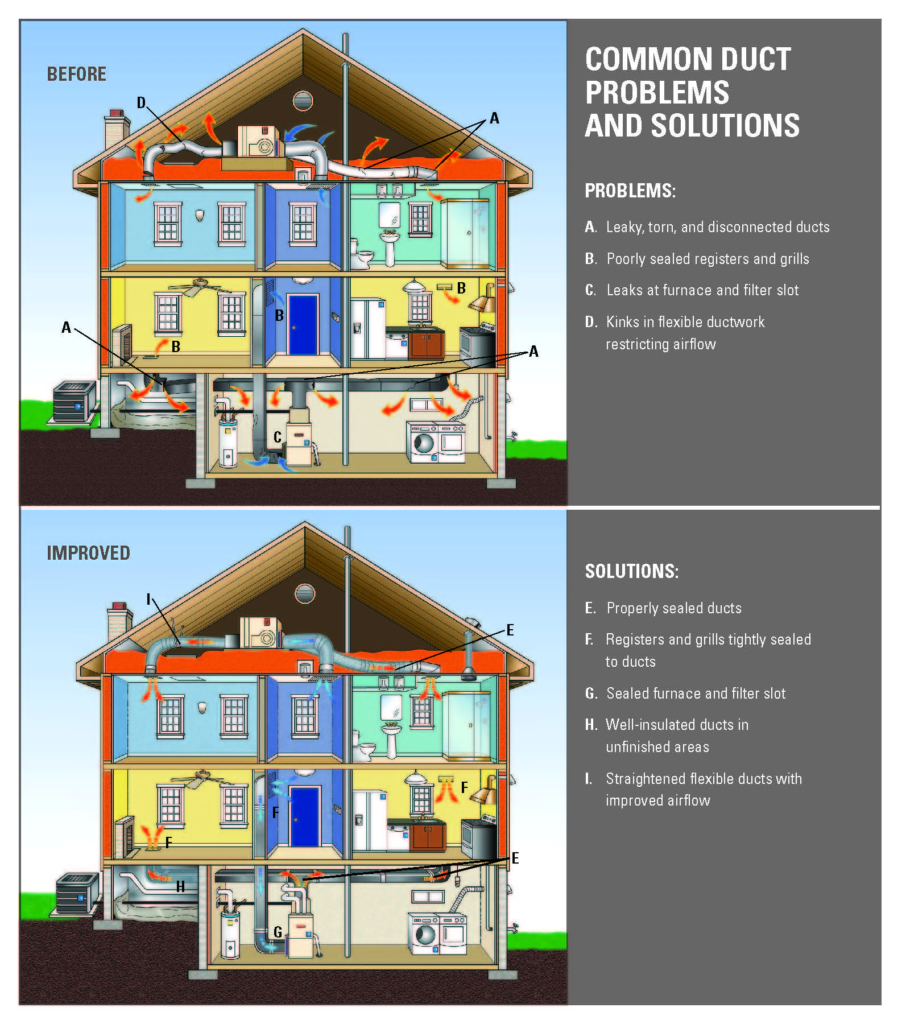
Let’s get to know our ducts. Single family residential homes in the Greater Phoenix area with a forced-air heating and cooling system has ducts. They are in the attic, in walls, within the sub-floor or in the basement depending on how your home was built. Ducts are used to distribute conditioned air throughout the house and are massively important. Do you have high utility bills, stuffy rooms, or a dusty house? It’s likely because of your ducts! In typical houses in Phoenix, about 20% of the air that moves through the duct system is lost due to leaks, holes, and poorly connected ducts. The result is higher utility bills and difficulty keeping the house comfortable, no matter how the thermostat is set. A duct system that is properly sealed and insulated can make your home more comfortable, energy efficient, and safer.
Making improvements to your duct system can:
Improve Comfort
Sealing and insulating ducts can help with common comfort problems, such as rooms that are too hot in the summer or too cold in the winter.
Enhance Indoor Air Quality
Fumes from household and garden chemicals, insulation particles, and dust can enter your duct system, aggravating asthma and allergy problems. Sealing ducts can help improve indoor air quality by reducing the risk of pollutants entering ducts and circulating through your home.
Promote Safety
During normal operation, gas appliances such as water heaters, clothes dryers, and furnaces release combustion gases (like carbon monoxide) through their venting systems. Leaky duckwork in your heating and cooling system may cause “backdrafting,” where these gases are drawn back into the living space, rather than expelled to the outdoors. Sealing leaks can reduce this risk.
Save Money
Leaky ducts can reduce heating and cooling system efficiency by as much as 20 percent. Sealing and insulating ducts increases efficiency, lowers your energy bills, and can often pay for itself in energy savings. Plus, if you’re planning to install new heating and cooling equipment, a well-designed and sealed duct system may allow you to downsize to a smaller, less costly heating and cooling system that will provide better dehumidification.
Some signs that your home may have leaky, poorly insulated, or inefficient ducts:
- you have high summer and winter utility bills;
- you have rooms that are difficult to heat and cool;
- you have stuffy rooms that never seem to feel comfortable;
- your ducts are located in the attic, unfinished basement, crawlspace, or the garage;
- you find tangled or kinked flexible ducts in your system.
Simple steps to improving duct performance
Since ducts are often concealed in walls, ceiling, attics, and basements, repairing them can be difficult. But there are things we can do to improve the duct performance in your home. Here’s what we’ll do:
- Inspect the whole duct system, including the attic, crawlspace, garage and basement as needed.
- Evaluate the system’s supply and return air balance. Many systems have return air ducts that are too small.
- Repair damaged and disconnected ducts and straighten out flexible ducts that are tangled or crushed.
- Seal all leaks and connections with duct mastic or metal tape.
- Seal all registers and grills tightly to the ducts.
- Insulate ducts in unconditioned areas with duct insulation that carries an R-value of 6 or higher.
- Include a new air filter as part of any duct system improvement.
- Evaluate airflow after repairs are completed.
- Ensure there is no backdrafting of gas appliances and conduct a combustion safety test after ducts are sealed.
Source: http://www.energystar.gov/index.cfm?c=heat_cool.pr_hvac

